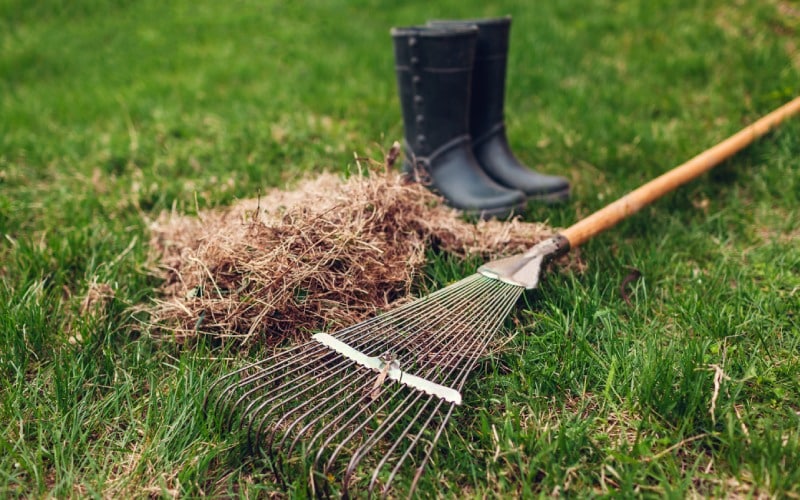Like other plants in your garden, new grass seed can be easily overwatered. Many homeowners want their lawns to thrive and are overly generous when watering their new grass seeds. Then, after a week of watering and puddles forming on their lawn, they are shocked and upset to find a bare yard.
Learn How To Avoid Overwatering Your New Grass
Overwatering is a very common mistake that people make when seeding their new lawn. They think that a lot of water will encourage growth and keep the grass healthy. This is not entirely true. It is important to water your grass seed correctly and frequently enough to encourage germination and the roots to grow. Too much water will leave your grass wet and dead.
After you have taken the time, money and effort to seed your new lawn, you don’t want to overwater it and have to start all over again. In this article, we will help you determine how much water your lawn needs and what your watering schedule should be. You will walk away with various tips and tricks on how to best water your new grass.

Use A Sprinkler
One of the main problems with watering new grass seed is that too much water can cause your new seed to be washed away. As water builds up, grass seeds can be pulled away from the soil in water runoff or puddles. This isn’t very helpful for growing lush, green grass!
To ensure that your newly seeded lawn stays seeded, water your lawn only until the soil is moist using an irrigation system. An irrigation system or sprinkler will ensure that water is evenly distributed across your lawn, much unlike a hose. Anything with a large amount of water pressure can also uproot seeds from the ground. It is best to choose a sprinkler that can reach all corners of your
How To Water New Grass Seed
Before you begin to seed your lawn, you should take care to make the soil moist. Soil moisture is one of the most important factors in helping new grass seed germinate and get established. Several days before planting grass seed, water your yard to a depth of 6 to 8 inches. You can check the moisture at this depth by pushing a screwdriver or peg deeply into the ground. If it goes in easily, it has been properly saturated.
After you plant grass seed, immediately water your yard for about 5 to 10 minutes. This will make sure that the surface of the soil is moist and help your seedlings get off to a great start.
Determine A Lawn Care Schedule
A watering schedule is a great way to ensuring that your new grass seed consistently gets enough water to encourage seed germination. There are many factors to consider when coming up with a watering schedule. Every person should consider their local weather forecast because it is possible to kill grass seeds through a combination of watering and rain.

Generally, new grass seed should be watered twice per day, once in the morning and then in the evening. The cool temperature in the morning and evening will ensure that the essential moisture has the opportunity to seep deep into your lawn early in the day. After the seeds receive the nutrients they need from an early morning watering, they can use the energy of the sun and the nutrients to grow into tall, well-established seedings. After your grass has sprouted, this schedule can be adjusted.
Adjust Your Watering As Grasses Grow
After planting your new lawn, you will need to adjust your watering schedule to ensure that your grass only receives an essential amount of water. Continuing to water your new grass like it was just planted will result in overwatering and cause it to die.
Grass seed should be watered two times a day (once in the mornings and once in the evening) before the seeds have sprouted. During this time, only water to keep the top 1-2 inches of the soil wet. Seeds will use the nutrients from the water to grow into seedlings.
As the weeks pass, the seeds will sprout and your bare lawn will be covered in growing grass. At first, you may only notice the light green tips of the plants, but their growth will dramatically increase as time passes. At this point, you can use less water on your lawn. Only water your lawn between 6-10 am and with enough water to make sure that 1 inch of the ground is moist. The roots of your grass will use this water to become more rooted in the soil.
Keep Your Grass Looking Healthy
If your region is experiencing a drought or your grass is looking brown and dull, you should take the time to water your lawn. Watering the top 1 inch of the soil of your well-established lawn can prevent your grass from dying. Water will seep 6-8 inches under your lawn, the point where a lawn’s roots are, and provide them with essential nutrients for growth. This will help keep your grass looking healthy all season long.

Power washing paved areas in the early spring can help elevate your outdoor space by getting rid of unwanted dirt and debris and, therefore, help to accentuate special shrubs and plants that you’ve taken the time to prune. One of the best tools to have is a paintbrush, a fresh can of paint, and a pressure washer.
Avoid Overwatering New Grass Seed With Sod
It can be difficult to avoid overwatering new grass seed. More often than not, people just want to see their lawn succeed. That is why they leave their sprinklers on too long, over saturating their soil and causing the seed to die or be carried away in runoff.
If you have tried seeding but have failed, sod installation may be a better option for you. While sod does require watering, it gives you a head start to creating a beautiful lawn.















